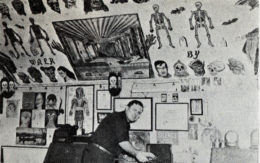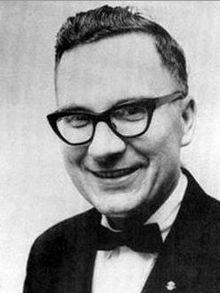by Charles Lear
 In the early years of the flying saucer mystery, the U.S. Air Force was the only organization doing any sort of significant investigation. Then, in 1952, a number of private groups were organized and the first citizen investigators went into the field and endeavored to solve the mystery for themselves. The first of these to rise to global attention was the International Flying Saucer Bureau, founded by Albert K. Bender. They put out a quarterly publication called Space Review, and were taken seriously by their fellow enthusiasts. They didn’t last long, however, as Bender put an end to his creation in 1953 after telling his followers he had solved the mystery. He later informed them he’d been visited by three men wearing black suits and homburg hats, who’d threatened him into keeping silent about his discovery. The mythos of the Men in Black entered flying saucer lore and the Bender Mystery became a subject that is still being debated today.
In the early years of the flying saucer mystery, the U.S. Air Force was the only organization doing any sort of significant investigation. Then, in 1952, a number of private groups were organized and the first citizen investigators went into the field and endeavored to solve the mystery for themselves. The first of these to rise to global attention was the International Flying Saucer Bureau, founded by Albert K. Bender. They put out a quarterly publication called Space Review, and were taken seriously by their fellow enthusiasts. They didn’t last long, however, as Bender put an end to his creation in 1953 after telling his followers he had solved the mystery. He later informed them he’d been visited by three men wearing black suits and homburg hats, who’d threatened him into keeping silent about his discovery. The mythos of the Men in Black entered flying saucer lore and the Bender Mystery became a subject that is still being debated today.
 Albert K. Bender was born on July 16, 1921 in Duryea, Pennsylvania. What the “K” stood for seems to be part of the mystery. He served stateside as a dental technician in the U.S. Army Air Forces from June 8, 1942 to Oct. 7, 1943. He was stationed at Langley Field, Virginia. After his service, he moved to Bridgeport, Connecticut with his mother and stepfather. His mother died shortly thereafter.
Albert K. Bender was born on July 16, 1921 in Duryea, Pennsylvania. What the “K” stood for seems to be part of the mystery. He served stateside as a dental technician in the U.S. Army Air Forces from June 8, 1942 to Oct. 7, 1943. He was stationed at Langley Field, Virginia. After his service, he moved to Bridgeport, Connecticut with his mother and stepfather. His mother died shortly thereafter.
Bender lived in the attic, which had a bedroom and a den. He was employed as the chief timekeeper at the Acme Shear Company. It may have been a conscious nod to his profession or just an ironic coincidence, but Bender had twenty clocks in his living space that all would ring, chime and clang every fifteen minutes.
The clocks were just one of the many manifestations of Bender’s eccentric nature that increasingly expressed itself as he entered his late twenties. He was a fan of horror movies, ghost stories and the occult. He adorned his attic space with Halloween decorations, fake skulls, shrunken heads, rubber spiders and snakes, and his own macabre paintings. When friends came over, he put on recordings of spooky noises and enjoyed showing off what he called his “Chamber of Horrors.” His offbeat interests and living space were interesting enough that an article was written about him and published in the May 25, 1952 Sunday Herald, a local Bridgeport newspaper. Read more